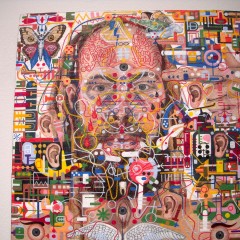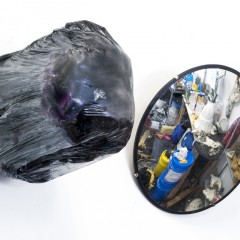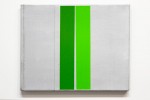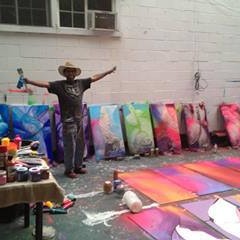With an American flag at its heart and a jaunty colored brick road on the floor, Abigail DeVille’s Gold Mountain should be upbeat. But the dark, cave-like installation at Marginal Utility is a sorrowful piece, a shrine almost. And the flag and crazy brick road are degraded symbols. Gold Mountain is a hell on earth.
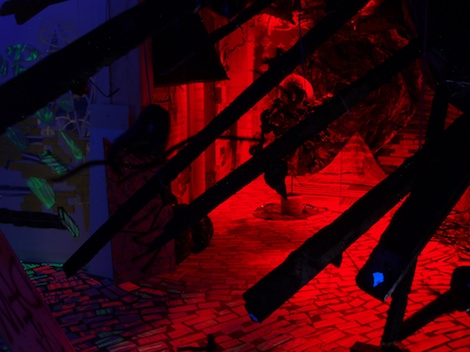
DeVille’s installation immerses you in dark space where you can imagine scary things happening. Dim lighting from black lights, red lights, and a small tv makes the space both eerie and fiery. Charred sticks poke out aggressively like cave ribs that might impale you. On the floor the tv’s static fuzz is like white ashes of a dead fire. There’s no central focus here. Instead the viewer, like a pilgrim, moves from one spot to another, stopping to contemplate and careful not to lose her footing.
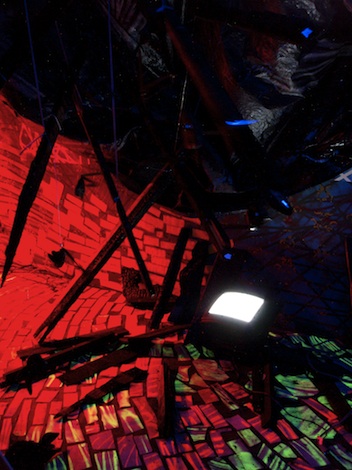
The artist painted a tumbling mass of dead birds and bricks on the dark walls. It looks like a whirlwind just passed through. “I use pigeons and crows as stand-ins for people,” DeVille told me.
The artist — who built Gold Mountain on site from material scavenged in Chinatown (including charred sticks from the nearby incinerated Trestle Inn) — spoke also of a Garcia Lorca poem “The Dawn.” Lorca’s poem imagines a New York at dawn that is “Dawn of the Dead” dark — everything but the zombies. The poet envisions columns of mud, a “hurricane of black doves,” “putrescent waters” and “light … buried under chains and noises” — those words could describe the ambiance of DeVille’s piece.
The title refers to the nickname the Chinese gave to California during the 1848 Gold Rush, when many immigrated here seeking their fortunes. (The term also refers ironically to the Chinatowns that were then springing up in San Francisco and elsewhere.) DeVille, a black artist and Yale MFA student, is a fount of information about the Chinese experience in America. At the opening she talked about the Chinese Exclusion Act, miscegenation laws and other harsh treatments doled out, peppering what she said with dates and references like she was as much history teacher as artist.
But Gold Mountain’s ire is aimed at all racial discrimination in America. Discrimination based on race is a part of American history that’s not dealt with four-squarely in history books, although many artists have no fear of the subject. Writers like James Baldwin and Ralph Ellison and artists like DeVille and, to mention just two others, Kara Walker and Hank Willis Thomas, expose the hidden history in ways that foster the discussion it needs.
Abigail DeVille: Gold Mountain Through Sept. 25, 2010. Marginal Utility 319A N. 11th St., 2nd floor 917.355.4487


